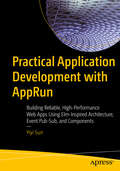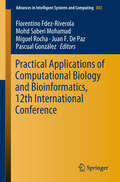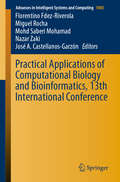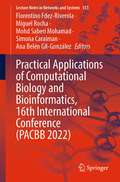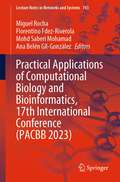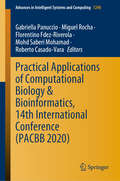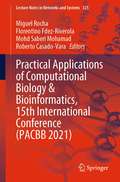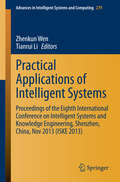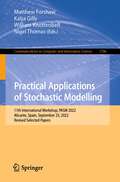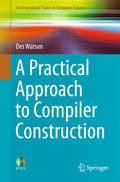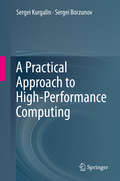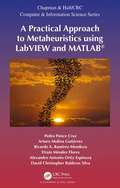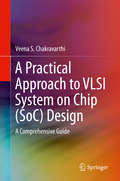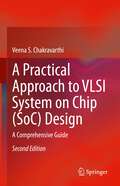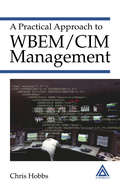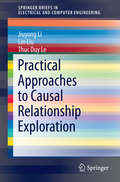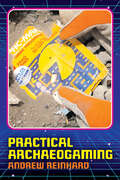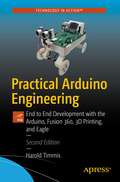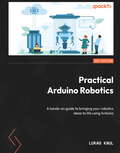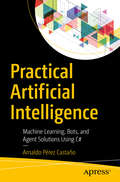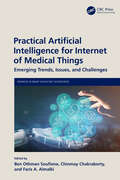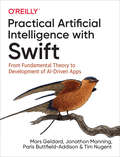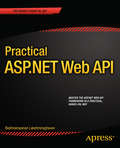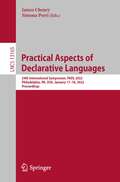- Table View
- List View
Practical Application Development with AppRun: Building Reliable, High-Performance Web Apps Using Elm-Inspired Architecture, Event Pub-Sub, and Components
by Yiyi SunExplore the concepts, patterns, and architecture behind AppRun applications. With this end-to-end guide, you will be able to build web apps fast to the market with the low learning curve and high development productivity. You will learn how to break down the application logic into three decoupled parts: state, view, and update. You will then see how to connect web page events to the AppRun event life-cycle, route user interactions, access data from the remote servers, compose the user interface using components, and integrate 3rd party libraries. Following examples of various apps, such as the counter app, to-do app, weather app, hacker news reader app, and blog app, you will have all the techniques for developing your AppRun apps including the line of business apps. You will also review wider development concepts such as using strongly typed states practically, unit testing strategies for app state changes, time travel debugging, async web API invocation, server-side virtual DOM, module compilation optimization, the developer tools, and more.What You'll LearnUse AppRun to develop web apps end-to-endUnderstand the technology behind AppRunEvaluate and compare architecture designDevelop applications using Elm architecture, event publication and subscription, and components. Who This Book Is For Web app developers and architects; useful for beginners learning front-end development and more experienced developers interested in learning about AppRun and modern development concepts and principles more generally
Practical Applications of Computational Biology and Bioinformatics, 12th International Conference (Advances In Intelligent Systems and Computing #803)
by Florentino Fdez-Riverola Mohd Saberi Mohamad Miguel Rocha Juan F. De Paz Pascual GonzálezThis book introduces the latest international research in the fields of bioinformatics and computational biology. It includes various studies in the area of machine learning in bioinformatics, systems biology, omics data analysis and mining, biomedical applications and sequences, which were selected by an international committee and presented at the 12th International Conference on Practical Applications of Computational Biology & Bioinformatics held in Toledo in June 2018.
Practical Applications of Computational Biology and Bioinformatics, 13th International Conference (Advances in Intelligent Systems and Computing #1005)
by Florentino Fdez-Riverola Miguel Rocha Mohd Saberi Mohamad Nazar Zaki José A. Castellanos-GarzónThis book features 21 papers spanning many different sub-fields in bioinformatics and computational biology, presenting the latest research on the practical applications to promote fruitful interactions between young researchers in different areas related to the field. Next-generation sequencing technologies, together with other emerging and diverse experimental techniques, are evolving rapidly, creating numerous types of omics data. These, in turn, are creating new challenges for the expanding fields of bioinformatics and computational biology, which seek to analyse, process, integrate and extract meaningful knowledge from such data. This calls for new algorithms and approaches from fields such as databases, statistics, data mining, machine learning, optimization, computer science, machine learning and artificial intelligence. Clearly, biology is increasingly becoming a science of information, requiring tools from the computational sciences. To address these challenges, we have seen the emergence of a new generation of interdisciplinary scientists with a strong background in the biological and computational sciences. In this context, the interaction of researchers from different scientific areas is, more than ever, vital to boost the research efforts in the field and contribute to the training of the new generation of interdisciplinary scientists.
Practical Applications of Computational Biology and Bioinformatics, 16th International Conference (Lecture Notes in Networks and Systems #553)
by Florentino Fdez-Riverola Miguel Rocha Mohd Saberi Mohamad Simona Caraiman Ana Belén Gil-GonzálezThis book is suitable for researchers and practitioners in biology, medicine and health sciences and bioinformatics. The success of bioinformatics and computational biology in recent years has been driven by research through computational tools and techniques that are essential for data analysis in modern biology and medicine.Systems biology is a related research area that has been replacing the reductionist view that dominated biology research in the last decades, requiring the coordinated efforts of biological researchers with those related to data analysis, mathematical modelling, computer simulation and optimization. The accumulation and exploitation of large-scale databases prompt new computational technology and for research into these issues. In this context, many widely successful computational models and tools used by biologists in these initiatives, such as clustering and classification methods for gene expression data, are based on computer science/ artificial intelligence (CS/AI) techniques. In fact, these methods have been helping in tasks related to knowledge discovery, modelling and optimization tasks, aiming at the development of computational models so that the response of biological complex systems to any perturbation can be predicted.This proceedings of the 16th International Conference on Practical Applications of Computational Biology and Bioinformatics (PACBB), held in L’Aquila (Italy) from July 13 to 15, 2022, contains ten original contributions of authors from many different countries (Bahrain, Canada, France, Italy, Portugal, Saudi Arabia, Spain, and UK) and different subfields in bioinformatics and computational biology.It is also suitable for artificial intelligence researchers interested in exploring applications in biology and health sciences and computational models.
Practical Applications of Computational Biology and Bioinformatics, 17th International Conference (Lecture Notes in Networks and Systems #743)
by Miguel Rocha Florentino Fdez-Riverola Mohd Saberi Mohamad Ana Belén Gil-GonzálezThis book aims to promote the interaction among the scientific community to discuss applications of CS/AI with an interdisciplinary character, exploring the interactions between sub-areas of CS/AI, bioinformatics, chemoinformatics, and systems biology. The success of bioinformatics in recent years has been prompted by research in molecular biology and molecular medicine in several initiatives. This year’s technical program presents both high quality and diversity, with contributions in well-established and evolving areas of research. The PACBB’23 technical program has selected 9 full papers in the main track and, as in past editions, it will be special issues in ranked journals. This symposium is organized by the LASI and Centro Algoritmi of the University of Minho (Portugal). The authors would like to thank all the contributing authors, the members of the program committee, national associations (AEPIA, APPIA), and the sponsors (AIR Institute).
Practical Applications of Computational Biology & Bioinformatics, 14th International Conference (Advances in Intelligent Systems and Computing #1240)
by Gabriella Panuccio Miguel Rocha Florentino Fdez-Riverola Mohd Saberi Mohamad Roberto Casado-VaraThis book highlights the latest research on practical applications of computational biology and bioinformatics, and addresses emerging experimental and sequencing techniques that are posing new challenges for bioinformatics and computational biology. Successfully applying these techniques calls for new algorithms and approaches from fields such as statistics, data mining, machine learning, optimization, computer science, and artificial intelligence. In response to these challenges, we have seen the rise of a new generation of interdisciplinary scientists with a strong background in the biological and computational sciences.These proceedings include 21 papers covering many different subfields of bioinformatics and computational biology. Focusing on interdisciplinary applications that combine e.g. bioinformatics, chemoinformatics, and system biology, they are intended to promote the collaboration of scientists from different research groups and with different backgrounds (computer scientists, mathematicians, biologists) to reach breakthrough solutions and overcome the challenges outlined above.
Practical Applications of Computational Biology & Bioinformatics, 15th International Conference (Lecture Notes in Networks and Systems #325)
by Miguel Rocha Florentino Fdez-Riverola Mohd Saberi Mohamad Roberto Casado-VaraThis book features novel research papers spanning many different subfields in bioinformatics and computational biology, presenting the latest research on the practical applications to promote fruitful interactions between young researchers in different areas related to the field. Clearly, biology is increasingly becoming a science of information, requiring tools from the computational sciences. To address these challenges, we have seen the emergence of a new generation of interdisciplinary scientists with a strong background in the biological and computational sciences. PACBB'21 expects to contribute to this effort by encouraging a successful collaboration of researchers in different areas related to bioinformatics. The PACBB'21 technical program included 17 papers covering many different subfields in bioinformatics and computational biology. Therefore, this conference, held in Salamanca (Spain), definitely promotes the collaboration of scientists from different research groups and with different backgrounds (computer scientists, mathematicians, biologists) to reach breakthrough solutions for these challenges.
Practical Applications of Intelligent Systems
by Zhenkun Wen Tianrui Li"Practical Applications of Intelligent Systems" presents selected papers from the 2013 International Conference on Intelligent Systems and Knowledge Engineering (ISKE2013). The aim of this conference is to bring together experts from different expertise areas to discuss the state-of-the-art in Intelligent Systems and Knowledge Engineering, and to present new research results and perspectives on future development. The topics in this volume include, but are not limited to: Intelligent Game, Intelligent Multimedia, Business Intelligence, Intelligent Bioinformatics Systems, Intelligent Healthcare Systems, User Interfaces and Human Computer Interaction, Knowledge-based Software Engineering, Social Issues of Knowledge Engineering, etc. The proceedings are benefit for both researchers and practitioners who want to learn more about the current practice, experience and promising new ideas in the broad area of intelligent systems and knowledge engineering. Dr. Zhenkun Wen is a Professor at the College of Computer and Software Engineering, Shenzhen University, China. Dr. Tianrui Li is a Professor at the School of Information Science and Technology, Southwest Jiaotong University, Xi'an, China.
Practical Applications of Stochastic Modelling: 11th International Workshop, PASM 2022, Alicante, Spain, September 23, 2022, Revised Selected Papers (Communications in Computer and Information Science #1786)
by Matthew Forshaw Katja Gilly William Knottenbelt Nigel ThomasThis book constitutes the referred proceedings of the 11th International Workshop on Practical Applications of Stochastic Modelling, PASM 2022, was held in Alicante, Spain, in September 2022.The 7 full papers presented in this volume were carefully reviewed and selected from 9 submissions. The papers demonstrate a diverse set of applications and approaches of stochastic modelling.
A Practical Approach to Compiler Construction
by Des WatsonThis book provides a practically-oriented introduction to high-level programming language implementation. It demystifies what goes on within a compiler and stimulates the reader's interest in compiler design, an essential aspect of computer science. Programming language analysis and translation techniques are used in many software application areas.A Practical Approach to Compiler Construction covers the fundamental principles of the subject in an accessible way. It presents the necessary background theory and shows how it can be applied to implement complete compilers. A step-by-step approach, based on a standard compiler structure is adopted, presenting up-to-date techniques and examples. Strategies and designs are described in detail to guide the reader in implementing a translator for a programming language.A simple high-level language, loosely based on C, is used to illustrate aspects of the compilation process. Code examples in C are included, together with discussion and illustration of how this code can be extended to cover the compilation of more complex languages. Examples are also given of the use of the flex and bison compiler construction tools. Lexical and syntax analysis is covered in detail together with a comprehensive coverage of semantic analysis, intermediate representations, optimisation and code generation. Introductory material on parallelisation is also included. Designed for personal study as well as for use in introductory undergraduate and postgraduate courses in compiler design, the author assumes that readers have a reasonable competence in programming in any high-level language.
A Practical Approach to High-Performance Computing
by Sergei Kurgalin Sergei BorzunovThe book discusses the fundamentals of high-performance computing. The authors combine visualization, comprehensibility, and strictness in their material presentation, and thus influence the reader towards practical application and learning how to solve real computing problems. They address both key approaches to programming modern computing systems: multithreading-based parallelizing in shared memory systems, and applying message-passing technologies in distributed systems. The book is suitable for undergraduate and graduate students, and for researchers and practitioners engaged with high-performance computing systems. Each chapter begins with a theoretical part, where the relevant terminology is introduced along with the basic theoretical results and methods of parallel programming, and concludes with a list of test questions and problems of varying difficulty. The authors include many solutions and hints, and often sample code.
A Practical Approach to Metaheuristics using LabVIEW and MATLAB® (Chapman & Hall/CRC Computer and Information Science Series)
by Pedro Ponce-Cruz Arturo Molina Gutiérrez Ricardo A. Ramírez-Mendoza Efraín Méndez Flores Alexandro Antonio Espinoza David Christopher SilvaMetaheuristic optimization has become a prime alternative for solving complex optimization problems in several areas. Hence, practitioners and researchers have been paying extensive attention to those metaheuristic algorithms that are mainly based on natural phenomena. However, when those algorithms are implemented, there are not enough books that deal with theoretical and experimental problems in a friendly manner so this book presents a novel structure that includes a complete description of the most important metaheuristic optimization algorithms as well as a new proposal of a new metaheuristic optimization named earthquake optimization. This book also has several practical exercises and a toolbox for MATLAB® and a toolkit for LabVIEW are integrated as complementary material for this book. These toolkits allow readers to move from a simulation environment to an experimentation one very fast. This book is suitable for researchers, students, and professionals in several areas, such as economics, architecture, computer science, electrical engineering, and control systems. The unique features of this book are as follows: Developed for researchers, undergraduate and graduate students, and practitioners A friendly description of the main metaheuristic optimization algorithms Theoretical and practical optimization examples A new earthquake optimization algorithm Updated state-of-the-art and research optimization projects The authors are multidisciplinary/interdisciplinary lecturers and researchers who have written a structure-friendly learning methodology to understand each metaheuristic optimization algorithm presented in this book.
A Practical Approach to Parallel Computing
by S. K. GhoshalThis book describes a way of building and using simple inexpensive parallel computers using PCs. It presents details of hardware, system software and application programming lucidly.
A Practical Approach to VLSI System on Chip (SoC) Design: A Comprehensive Guide
by Veena S. ChakravarthiThis book provides a comprehensive overview of the VLSI design process. It covers end-to-end system on chip (SoC) design, including design methodology, the design environment, tools, choice of design components, handoff procedures, and design infrastructure needs. The book also offers critical guidance on the latest UPF-based low power design flow issues for deep submicron SOC designs, which will prepare readers for the challenges of working at the nanotechnology scale. This practical guide will provide engineers who aspire to be VLSI designers with the techniques and tools of the trade, and will also be a valuable professional reference for those already working in VLSI design and verification with a focus on complex SoC designs.A comprehensive practical guide for VLSI designers;Covers end-to-end VLSI SoC design flow;Includes source code, case studies, and application examples.
A Practical Approach to VLSI System on Chip (SoC) Design: A Comprehensive Guide
by Veena S. ChakravarthiNow in a thoroughly revised second edition, this practical practitioner guide provides a comprehensive overview of the SoC design process. It explains end-to-end system on chip (SoC) design processes and includes updated coverage of design methodology, the design environment, EDA tool flow, design decisions, choice of design intellectual property (IP) cores, sign-off procedures, and design infrastructure requirements. The second edition provides new information on SOC trends and updated design cases. Coverage also includes critical advanced guidance on the latest UPF-based low power design flow, challenges of deep submicron technologies, and 3D design fundamentals, which will prepare the readers for the challenges of working at the nanotechnology scale. A Practical Approach to VLSI System on Chip (SoC) Design: A Comprehensive Guide, Second Edition provides engineers who aspire to become VLSI designers with all the necessary information and details of EDA tools. It will be a valuable professional reference for those working on VLSI design and verification portfolios in complex SoC designs
A Practical Approach to WBEM/CIM Management
by Chris HobbsSystem architects and engineers in fields such as storage networking, desktop computing, electrical power distribution, and telecommunications need a common and flexible way of managing heterogeneous devices and services. Web-Based Enterprise Management (WBEM) and its Component Information Model (CIM) provide the architecture, language, interfaces,
Practical Approaches to Causal Relationship Exploration
by Jiuyong Li Lin Liu Thuc Duy LeThis brief presents four practical methods to effectively explore causal relationships, which are often used for explanation, prediction and decision making in medicine, epidemiology, biology, economics, physics and social sciences. The first two methods apply conditional independence tests for causal discovery. The last two methods employ association rule mining for efficient causal hypothesis generation, and a partial association test and retrospective cohort study for validating the hypotheses. All four methods are innovative and effective in identifying potential causal relationships around a given target, and each has its own strength and weakness. For each method, a software tool is provided along with examples demonstrating its use. Practical Approaches to Causal Relationship Exploration is designed for researchers and practitioners working in the areas of artificial intelligence, machine learning, data mining, and biomedical research. The material also benefits advanced students interested in causal relationship discovery.
Practical Archaeogaming
by Andrew ReinhardAs a sequel to Archaeogaming: an Introduction to Archaeology in and of Video Games, the author focuses on the practical and applied side of the discipline, collecting recent digital fieldwork together in one place for the first time to share new methods in treating interactive digital built environments as sites for archaeological investigation. Fully executed examples of practical and applied archaeogaming include the necessity of a rapid archaeology of digital built environments, the creation of a Harris matrix for software stratigraphy, the ethnographic work behind a human civilization trapped in an unstable digital landscape, how to conduct photogrammetry and GIS mapping in procedurally generated space, and how to transform digital artifacts into printed three-dimensional objects. Additionally, the results of the 2014 Atari excavation in Alamogordo, New Mexico are summarized for the first time.
Practical Arduino Engineering: End to End Development with the Arduino, Fusion 360, 3D Printing, and Eagle
by Harold TimmisImplement Arduino-based designs in your project, and build, debug, and extend it using a solid engineering approach. This second edition is expanded to provide a better understanding of the engineering process and what it means to be an end-to-end developer. You’ll start out by reviewing basic engineering procedures, from the fundamental requirements and preliminary design to prototyping and testing. You’ll then apply those principles to single devices like LCDs, potentiometers and GPS modules, and move on to the integration of several modules into a larger project, a sub-autonomous robot. This robot will include devices such as GPS, Bluetooth, an OLED screen, an accelerometer, humidity and temp sensor, motor drivers, and ultrasonic sensor. This version goes on to cover how to create 3D models with Fusion360, make your own PCBs using Eagle, and use and maintain a 3D printer. Each and every chapter exemplifies this process and demonstrates how you can profit from the implementation of solid engineering principles—regardless of whether you just play in your basement or you want to publicize and sell your devices. With Practical Adruino Engineering you’ll be able to review and improve this process, and even extend its scope. What You’ll Learn ● Set up the Arduino software landscape and project for testing ● Review the process of hardware engineering as applicable to Arduino projects ● Create 3D models for 3D printing using Fusion360 in a robot chassis project ● Make PCBs using Eagle and incorporate it into a sensor station shield project ● Use and maintain a 3D printer with your own project ● Create Arduino shields in Eagle ● Debug Arduino projects of varying complexities via LabVIEW ● Use a special Arduino board for Bluetooth to control domestic and mobile Arduino projects Who This Book Is For Primarily aimed at intermediate engineers or engineering students. However, this book is also great for beginners and any maker who wants to expand their abilities in a single book.
Practical Arduino Robotics: A hands-on guide to bringing your robotics ideas to life using Arduino
by Lukas KaulBuild your hardware, electronics, and programming skills, and use them to realize your advanced robotics projects with this powerful platformPurchase of the print or Kindle book includes a free PDF eBookKey FeaturesBecome an expert in selecting sensors, motors, and Arduino boards for any robotics projectDiscover how to write effective and reusable code for your Arduino robotics projectsLearn to build a camera-based line follower and a self-balancing telepresence robot on your ownBook DescriptionEvery robot needs a “brain,” and the Arduino platform provides an incredibly accessible way to bring your Arduino robot to life. Anyone can easily learn to build and program their own robots with Arduino for hobby and commercial uses, making Arduino-based robots the popular choice for school projects, college courses, and the rapid prototyping of industrial applications!Practical Arduino Robotics is a comprehensive guide that equips you with the necessary skills and techniques that can be applied to various projects and applications, from automating repetitive tasks in a laboratory to building engaging mobile robots.Building on basic knowledge of programming and electronics, this book teaches you how to choose the right components, such as Arduino boards, sensors, and motors, and write effective code for your robotics project, including the use of advanced third-party Arduino libraries and interfaces, such as Analog, SPI, I2C, PWM, and UART. You'll also learn different ways to command your robots wirelessly, such as over Wi-Fi. Finally, with basic to advanced project examples, this book illustrates how to build exciting autonomous robots like a self-balancing telepresence robot.By the end of this book, you'll be able to design and create your own custom robots for a wide variety of applications.What you will learnUnderstand and use the various interfaces of an Arduino boardWrite the code to communicate with your sensors and motorsImplement and tune methods for sensor signal processingUnderstand and implement state machines that control your robotImplement feedback control to create impressive robot capabilitiesIntegrate hardware and software components into a reliable robotic systemTune, debug, and improve Arduino-based robots systematicallyWho this book is forIf you're excited about robotics and want to start creating your own robotics projects from the hardware up, this book is for you. Whether you are an experienced software developer who wants to learn how to build physical robots, a hobbyist looking to elevate your Arduino skills to the next level, or a student with the desire to kick-start your DIY robotics journey, you'll find this book very useful. In order to successfully work with this book, you'll need basic familiarity with electronics, Arduino boards and the core concepts of computer programming.
Practical Artificial Intelligence: Machine Learning, Bots, and Agent Solutions Using C#
by Arnaldo Pérez CastañoDiscover how all levels Artificial Intelligence (AI) can be present in the most unimaginable scenarios of ordinary lives. This book explores subjects such as neural networks, agents, multi agent systems, supervised learning, and unsupervised learning. These and other topics will be addressed with real world examples, so you can learn fundamental concepts with AI solutions and apply them to your own projects.People tend to talk about AI as something mystical and unrelated to their ordinary life. Practical Artificial Intelligence provides simple explanations and hands on instructions. Rather than focusing on theory and overly scientific language, this book will enable practitioners of all levels to not only learn about AI but implement its practical uses.What You’ll LearnUnderstand agents and multi agents and how they are incorporatedRelate machine learning to real-world problems and see what it means to youApply supervised and unsupervised learning techniques and methods in the real worldImplement reinforcement learning, game programming, simulation, and neural networksWho This Book Is ForComputer science students, professionals, and hobbyists interested in AI and its applications.
Practical Artificial Intelligence for Internet of Medical Things: Emerging Trends, Issues, and Challenges (Advances in Smart Healthcare Technologies)
by Ben Othman Soufiene Chinmay Chakraborty Faris A. AlmalkiThis book covers the fundamentals, applications, algorithms, protocols, emerging trends, problems, and research findings in the field of AI and IoT in smart healthcare. It includes case studies, implementation and management of smart healthcare systems using AI. Chapters focus on AI applications in Internet of Healthcare Things, provide working examples on how different types of healthcare data can be used to develop models and predict diseases using machine learning and AI, with the real-world examples. This book is aimed at Researchers and graduate students in Computer Engineering, Artificial Intelligence and Machine Learning, Biomedical Engineering, and Bioinformatics. Features: Focus on the Internet of Healthcare Things and innovative solutions developed for use in the application of healthcare services Discusses artificial intelligence applications, experiments, core concepts, and cutting-edge themes Demonstrates new approaches to analyzing medical data and identifying ailments using AI to improve overall quality of life Introduces fundamental concepts for designing the Internet of Healthcare Things solutions Includes pertinent case studies and applications This book is aimed at researchers and graduate students in Computer Engineering, Artificial Intelligence and Machine Learning, Biomedical Engineering, and Bioinformatics.
Practical Artificial Intelligence with Swift: From Fundamental Theory to Development of AI-Driven Apps
by Mars Geldard Jonathon Manning Paris Buttfield-Addison Tim NugentCreate and implement AI-based features in your Swift apps for iOS, macOS, tvOS, and watchOS. With this practical book, programmers and developers of all kinds will find a one-stop shop for AI and machine learning with Swift. Taking a task-based approach, you’ll learn how to build features that use powerful AI features to identify images, make predictions, generate content, recommend things, and more.AI is increasingly essential for every developer—and you don’t need to be a data scientist or mathematician to take advantage of it in your apps. Explore Swift-based AI and ML techniques for building applications. Learn where and how AI-driven features make sense. Inspect tools such as Apple’s Python-powered Turi Create and Google’s Swift for TensorFlow to train and build models.I: Fundamentals and Tools—Learn AI basics, our task-based approach, and discover how to build or find a dataset.II: Task Based AI—Build vision, audio, text, motion, and augmentation-related features; learn how to convert preexisting models.III: Beyond—Discover the theory behind task-based practice, explore AI and ML methods, and learn how you can build it all from scratch... if you want to
Practical ASP.NET Web API
by Badrinarayanan LakshmiraghavanPractical ASP. NET Web API provides you with a hands-on and code-focused demonstration of the ASP. NET Web API in action. From the very beginning, you'll be writing working code in order to see best practices and concepts in action. As the book progresses, the concepts and code will become more sophisticated. Beginning with an overview of the web service model in general and Web API in particular, you'll progress quickly to a detailed exploration of the request binding and response formatting that lie at the heart of Web API. You'll investigate various scenarios and see how they can be manipulated to achieve the results you need. Later in the book more sophisticated themes will be introduced that will set your applications apart from the crowd. You'll learn how you can validate the request messages on arrival, how you can create loosely coupled controllers, extend the pipeline processing to compartmentalize your code for security and unit testing before being put onto a live hosting server. What you'll learn What ASP. NET Web API is and how it can be used effectively Ways to optimize your code for readability and performance What controller dependencies are and why they matter How to maintain robust security across your projects Reliable best-practices for using Web API in a professional context Who this book is for The book is ideal for any . NET developer who wants to learn how the ASP. NET Web API framework works in a realistic setting. A good working knowledge of C# and the . NET framework and a familiarity with Visual Studio are the only pre-requisites to benefit from this book Table of Contents Building a Basic Web API Debugging HTTP Formatting CLR Objects into HTTP Response Customizing Response Binding HTTP Request into CLR Objects Validating Request Managing Controller Dependencies Extending Pipeline Hosting ASP. NET Web API Securing ASP. NET Web API Consuming ASP. NET Web API Building Performant Web API
Practical Aspects of Declarative Languages: 24th International Symposium, PADL 2022, Philadelphia, PA, USA, January 17–18, 2022, Proceedings (Lecture Notes in Computer Science #13165)
by James Cheney Simona PerriThis book constitutes the refereed proceedings of the 24th International Conference on Practical Aspects of Declarative Languages, PADL 2022, held in Philadelphia, PA, USA, during January 17-18, 2022. The 9 full papers and 4 short papers included in this book were carefully reviewed and selected from 22 submissions. They were organized in topical sections as follows: answer set programming; functional programming; languages, methods and tools; and declarative solutions.
